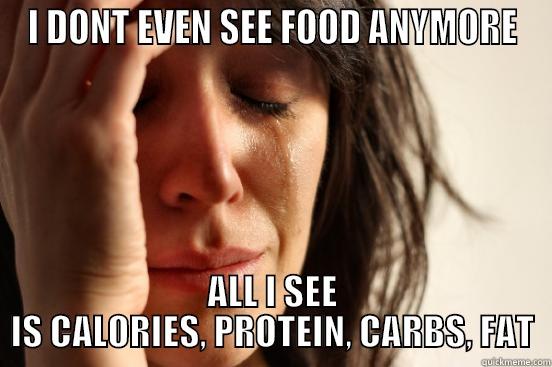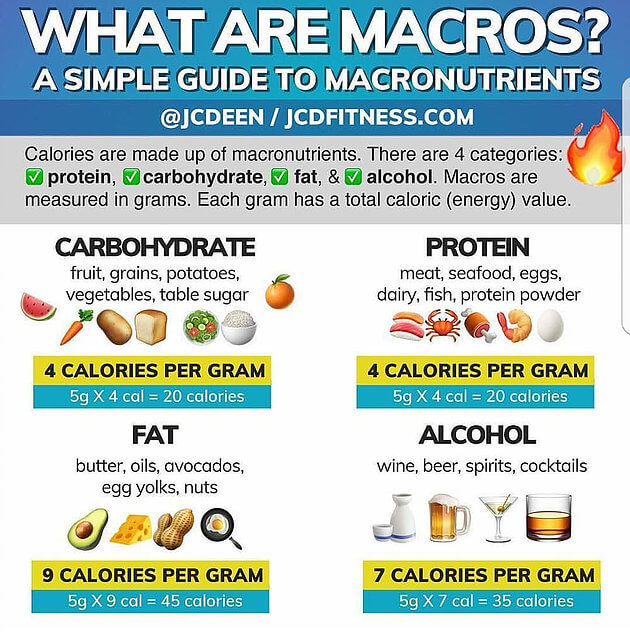If you are a fitness freak or a member of the health-conscious community, then you’ve probably come across the commonly buzzed-about term “Macros” when the topic of diets comes up. Well, macros are simply macronutrients. Many people know them better as proteins, fats, and carbohydrates.
For a long time now, we have been stuck on the general idea that if you want to lose weight, you have to burn more calories than you consume to create a calorie deficit. We’ve shifted our attention to counting calories and forgotten about how balanced our diets should be. For optimal health, however, knowing how to count your macros is far more important than you realize.
Macronutrients are the building blocks of nutrition. Your body requires a lot of the BIG 3 nutrients to function properly. That’s the reason you’re told: “if it fits your macros, eat it”. IIFYM is a flexible dieting technique that allows people to shed some extra pounds without feeling overly restricted with their eating habits. You can enjoy all the foods, as long as they fit into your daily macros.
So why does counting your macros matter? And how do go about calculating your macros? In this post, we’ve covered everything you need to know in this regard.
Let’s get started.

Why you should count your macros
Tracking your macros could be a secret to your fitness success. It can help simplify your weight maintenance and loss journey, thus determining your physique level. When you know the right ratio of proteins, fats, and carbs you need daily, it will become a lot easier to reach your various health goals.
Keep in mind though that tracking your macronutrients isn’t a surefire way to being ripped or getting peak health from the inside out. However, it’s a good technique for anyone looking to get the most of this journey.
While it’s possible to reach your goals without keeping track of your macros, getting there is generally far from being efficient and fun. At some point, you may have to deal with the frustrations of having not made a significant impact regardless of your great efforts. It would be like driving to an unfamiliar location without a road map, GPS, or any other useful pointers.
Related: The Secret to Carb Cycling for Fat Loss
Calorie values for each macronutrient
The first step to counting macronutrients successfully is to know the value of calories for each of the 3 macros. We’ll try to simplify everything for you, in a more step by step manner.
• Carbohydrates
Carbohydrates will, often than not, make up the largest portion of most peoples’ daily calorie intakes. Carbs are sugars, starches, and fibers. They are broken down into blood sugar to provide the body with energy. The unused glucose will be stored in your liver and muscles as glycogen.
Well, each gram of carbohydrates provides 4 calories.
• Proteins
You need proteins for proper immune functioning and cell signaling. These macronutrients are also essential in the building of tissues, enzymes, and hormones.
Like carbohydrates, 1 gram of proteins provides 4 calories.
• Fats
Fats are crucial for providing your body not only with energy but also supporting other functions, including the absorption of nutrients, production of hormones, and maintenance of body temperature.
Unlike carbs and proteins, fats offer 9 calories per gram.

Figuring your caloric needs
Having understood the calorie values for each macronutrient, it’s time to find out how much overall calories you will need to consume per day. Some people will need different amounts of calories than others, generally depending on their body weight and level of activity.
You can use an online calculator to figure out your overall calorie needs, but here is a more basic way to go about it.
If you usually spend most of your working hours seated but somehow you get physically active during your free time, then your overall calorie needs will be to multiply your body weight by 12g.
For people that want to lose a significant amount of weight (at least 30lbs), it will be ideal to multiply the body weight by 11g. Want to be ultra-aggressive? Well, just multiply your body weight by 10g.
Now let’s get a little more practical…
We will use 12g because most people are believed to fall into this category. We generally mean the level of office workers, which are typically lightly to moderately active.
Let’s assume your body weight is around 200lbs. When multiplying that body weight by 12, the total will be 2,400. This is the approximated amount of calories you will need per day.
What does this mean? If you are going to consume this same amount of calories every day, expect little to no significant effect on your body weight. If you exceed, you’re more likely to add weight. Cutting down on calories could mean losing weight.
Needless to say, the results are connected to a variety of factors like age, level of activity, metabolism, genetics, and hormones.
Macronutrient breakdown — how do you count your macros?
Once you’ve determined the number of calories needed by your body every day, it’s important to find out what makes up those calories. That way, you’ll know the macro ratios which fit your specific needs.
How you will look if your calories are made up of 55% carbs, 30% fat, and 15% protein will be quite different from consuming 45% carbs, 35% fats, and 20% proteins.
While you may have about the same weight, you will without a doubt notice a major difference in your body fat and composition.
Recommended macronutrient ratio
You can fine-tune your macronutrient ratio to see what works best for you. The ratios can vary based on your dietary preferences, health goals, body type, and level of activity. But here are the generally recommended ratios:
• Carbohydrates can make up 45% to 65 % of your total calories
• Fats can make up 20% to 35% of your total calories
• Proteins can make up 10% to 35% of your total calories
Proteins ratio:
The recommended amount of daily protein is anywhere between .65g to 1g per lbs. of your total body weight.
Let’s use our previous example… Assuming your body weight is 200lbs and you want to get ripped, what would be the ideal amount of protein you will need? Your daily target will be to eat 200g of protein. For maintaining your weight, 130g will be ideal.
Fats ratio:
On a high-fat diet, you will need g fat per lbs of your body weight. For a 200lbs folk, that means you need to eat 100g of fat daily. When starting out with counting macros, it is recommended to keep your daily consumption of fat to at least 25%.
Carbs ratio:
We had mentioned earlier that carbohydrates often make up the largest portion of most peoples’ calorie intake. However, some people may choose a low carb, high-fat diet like in our case now. And it is easy to calculate how much you need for each day.
Remember we said each macronutrient has a specific amount of calories. Since you already know your protein calories are 200g x 4 (800 calories) and fat calories 100g x 9 (900 calories), you will have a deficit of 700. This is the total number of your daily calories for carbs. 700 calories translate to 175 grams of carbs.
Now your ideal daily intake of macronutrients for a 2,400 calories diet would look like 175 grams carbs, 200 grams proteins, and 100 grams fats.
One more time, please note that the recommendations and examples we’ve listed in this post may not be ideal for your unique weight and physique needs. If, for example, your objective is to achieve better blood sugar control and shed off some extra pounds, a diet consisting of 35% carbs, 35% proteins, and 30% fats may prove rewarding.

Tracking your macros
Tracking your macros doesn’t have to be hard anymore. Today, you have access to some really useful apps and websites where you can log the foods you eat and monitor your progress. This will help you make more informed decisions.
For example, you can use applications like MyFitnessPal, My Macros +, or Lose It! They are the most popular and convenient options for tracking your macros.
You can also opt for a digital food scale for weighing your food before logging it into tracking apps or websites. However, we must say this option is not that necessary.
Other people may prefer hand-writing macros into a physical food journal.

Getting a good start with keeping track of your macros
It’s worth noting that what works best for your friend may or probably will not work for you. So if you want to get the most of this whole thing, you need to start on the right foot.
We recommend that you consider working with an experienced coach when starting out with calculating your macros. A professional coach will advise you accordingly, make diet suggestions, review your progress, and recommend adjustments if deemed necessary.
Conclusion
Mastering the numbers may be your biggest secret to weight loss, maintenance, and shaping your physique. When you count your macros, however, it is not necessary to hit your exact target. It’s okay to consume slightly more or fewer grams each day. You will still be able to achieve your goals.
There you have it! And we hope you enjoyed reading this article and it indeed helped you.

Ryan is a former college wrestler and lifelong fitness fanatic. He has run half marathons, done mud runs, placed in body transformation contests, coached wrestling, and now coaches girls’ soccer. Not to mention he has also tried literally hundreds of supplements over the years and has a vast and thorough supplement knowledge. He has written for Muscle & Strength, Testosterone Junkie, The Sport Review and other publications. He is also the editor-in-chief of this website and has over 25 years of experience in the fitness industry. Feel free to connect with him on his LinkedIn page below.








